Marc-Antoine Charpentier – Te Deum
Marc-Antoine Charpentier – Te Deum
Perhaps no piece of music evokes more pungently our image of the court of the Sun King, Louis XIV, than the well-loved ‘Prelude’ to Marc-Antoine Charpentier's ‘To Deum.’ Yet, though Louis may at some time have heard this setting of the canticle, it was not in fact written for the court at all but, in all probability, for one of the Paris churches with which Charpentier was at one time associated. It is one of the ironies of music history that Marc-Antoine Charpentier never held formal ties to the royal court of France. Nevertheless he became most famous for this “Te Deum H.146 in D,” which was written in celebration of a military victory by King Louis XIV.
Marc-Antoine Charpentier – Te Deum
Marc-Antoine Charpentier (1643-1704) had no formal links with the court, where Lully’s music held sway. But he did have limited contact with the court, mainly through relatives of the king. Charpentier worked as house composer to Marie de Lorraine, duchesse de Guise, who was known familiarly as "Mlle de Guise.”
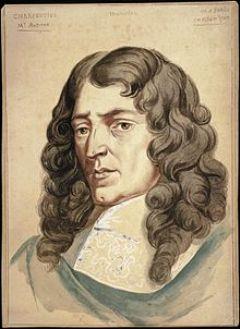
Marc-Antoine Charpentier
It is not quite certain for which event the Te Deum was written, but it seems likely it was the victory at Steinkerque in August 1692; François Couperin refers to this event in his “Sonata La Steinkerque.” The choice of the key of D major is highly appropriate: the German theorist Johann Mattheson links this key to 'military things'. Charpentier considered the key D-major as ‘bright and very warlike’.

Louis XIV - Sun King
The composition is scored for five soloists (SSATB) and choir (SATB), accompanied with an instrumental ensemble of 2 nonspecified recorders or flutes, 2 oboes, 2 trumpets (second trumpet in unison with timpani), timpani, 2 violins, 2 violas ("haute-contres de violon" and "tailles de violon") and basso continuo.
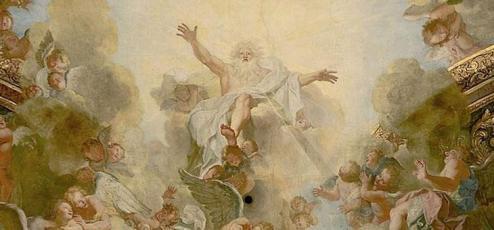
Te Deum (Versailles)
The composition consists of the following parts:
Prelude (Marche en rondeau)
Te Deum laudamus (bass solo)
Te aeternum Patrem (chorus and SSAT solo)
Pleni sunt caeli et terra (chorus)
Te per orbem terrarum (trio, ATB)
Tu devicto mortis aculeo (chorus, bass solo)
Te ergo quaesumus (soprano solo)
Aeterna fac cum sanctis tuis (chorus)
Dignare, Domine (duo, SB)
Fiat misericordia tua (trio, SSB)
In te, Domine, speravi (chorus with ATB trio)
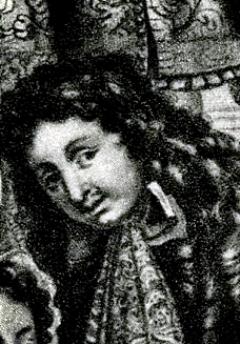
Marc-Antoine Charpentier
This Te Deum may reflect the pomp and circumstance which one expects from such a composition. There is also a close connection between text and music. The triple "Sanctus" causes the use of three solo voices and so does the reference to the Trinity in the fifth section (Te per orbem terrarum). "Pleni sunt coeli" (Heaven and earth are full of the majesty of Thy glory) is obviously set for the tutti. The intimate prayer "Te ergo quaesumus" (We therefore pray Thee) is given to a solo soprano.
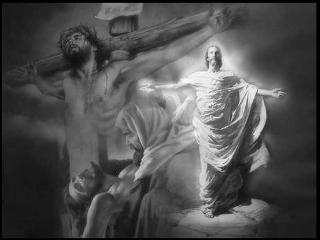
Te Deum
The text contains strong contrasts: for instance, a passage about the Last Judgement is followed by prayers for God’s mercy. These contrasts are fully exploited by the composer, both in the scoring and the affetti. Contrasts in music were something Charpentier was specifically interested in: ‘the very diversity is what creates perfection’. There can't be any doubt that what we see here is the influence of his teacher, Giacomo Carissimi, who was especially famous for his oratorios which had a strongly dramatic character.
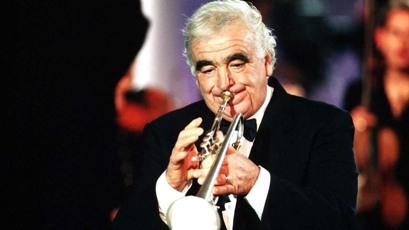
Maurice Andre plays Prelude to Te Deum
The opening track Prelude (notably the trumpet and drum fanfare) is instantly recognizable, but once past that the present-day association gives way to the sense of historical occasion. In addition to trumpets and drums (which return in three further movements), Charpentier used other colourful instruments.
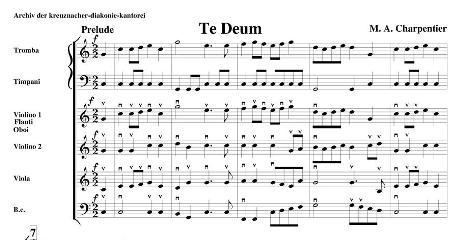
Prelude to Te Deum
After the work's rediscovery in 1953 by the musicologist Carl de Nys, the instrumental prelude, “Marche en rondeau,” was chosen in 1954 as the theme music preceding the broadcasts of the European Broadcasting Union. After over sixty years of use notably before EBU programs such as the popular Eurovision Song Contest and Jeux Sans Frontières, the prelude, as arranged by Guy Lambert and directed by Louis Martini, has become Charpentier's best-known work.
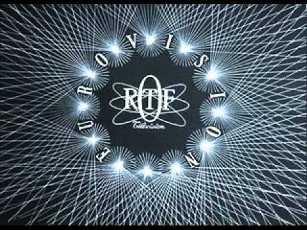
Eurovison (European Broadcasting Union)
Charpentier – Te Deum Prelude (Chapelle Royale de Versailles)
Last Updated (Monday, 03 July 2017 16:17)








